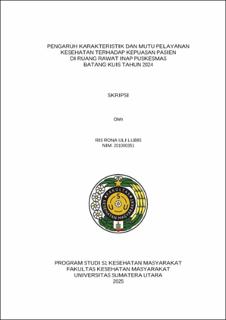| dc.description.abstract | Humans as living beings have different characteristics from one another, therefore humans, in this case referred to as patients, have different expectations or standards of satisfaction when they are getting health services, one of which is in the inpatient room of the puskesmas. Patient satisfaction will never be separated from the quality of health services, the more perfect the quality of health services received by patients, the higher the level of patient satisfaction. as for patient satisfaction is measured by the five dimensions, namely tangibles, reliability, responsiveness, assurance and empathy. This study aims to determine the effect of characteristics (gender, age, education level, occupation and income) and the quality of health services on patient satisfaction carried out in the Batang Kuis Health Center inpatient room. This type of research uses quantitative methods with a cross sectional approach with sampling using incidental sampling techniques and a sample size of 50 people was obtained. Characteristics and quality of health services were collected using questionnaires and measured using logistic regression tests. Data analysis used univariate, bivariate and multivariate analysis. Based on the results of the study, it shows that there is an influence between the level of education (p=0.044), occupation (p=0.042) and income (0.044) on patient satisfaction in the inpatient room. It is recommended that the Batang Kuis Health Center Inpatient Installation is expected to evaluate every service and action provided by health workers to patients in order to increase patient satisfaction with the services received. | en_US |


